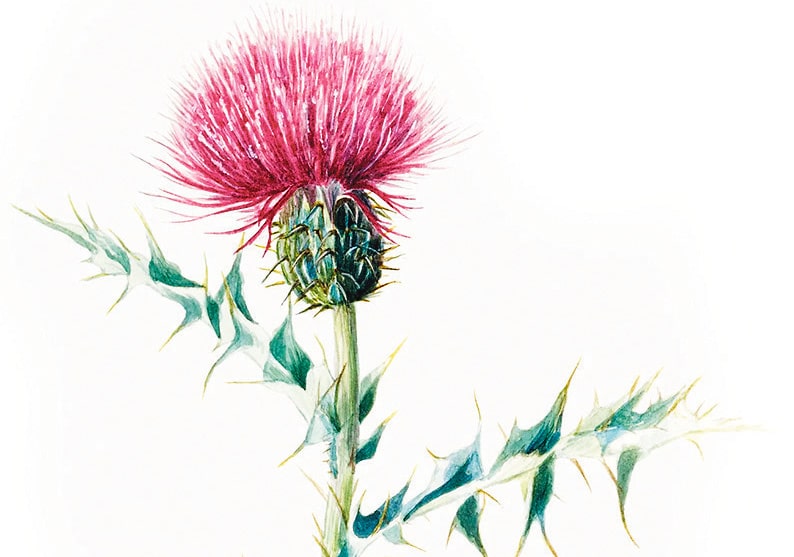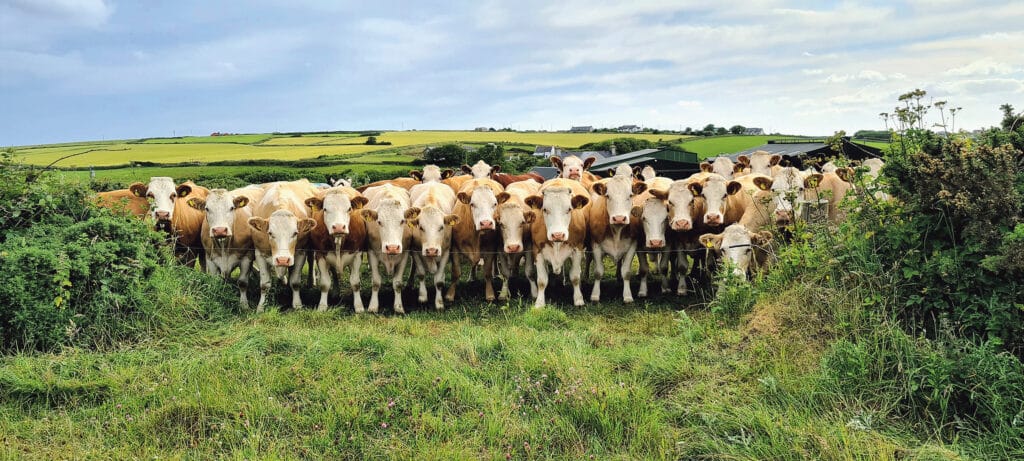We have all heard that a four-leaved clover is lucky but the ‘hungry-grass’ was quite the opposite and very unlucky indeed for anyone who stood on it. ‘Hungry grass’ cannot be distinguished from other kinds of grass. It is said to grow on the spot where some poor person died of starvation in famine times, and when you step on it you suffer the pangs of hunger. Older people carried a bread crust in their pocket, as a precaution, for the smallest morsel of bread banished the hunger.
There were many wild plants with peculiar properties and uses. In damp places, such as marshes or river banks, the Irish Spurge, ‘Bainne Cín na nÉan’, grows in great yellow-green clumps. Its juice was used to remove warts but it also had a sinister use – poisoning fish. People filled a canvas bag with spurge, pounded the sack until the contents were beaten into a juicy pulp and then dropped it into the river. The result was that every fish – eels, trout and salmon and so on, came floating dead to surface for hundreds of yards downstream. The purpose must have been to anger the local landlord who in the past ‘owned’ the fishing rights to the rivers.
When men went to the bog or the hill they were often asked to bring back a bunch of heather, used by the womenfolk as brooms and scrapers. The ‘long heather’ was made into brooms and the shorter stiff heather was used for its colour and fragrance. White heather was also considered lucky.
Many of the wild plants were used in folk cures and quite a few were eaten as food. Many of the older people ate a dish of boiled nettles three times in May when the nettles were young and green. This was for health reasons because nettles are a renowned blood purifier. ‘Praiseach Bhuí’ (charlock) was gathered and boiled for food in hard times.
Of course wild fruits were eaten. The favourite was the ‘fraochán’, the blue whortleberry that grew in profusion in the bogs. The blackberry, the crab-apple, the sloe and the hazelnut were gathered and eaten. Blackberries, in particular, were used for making jam. In places sloes, elderberries and other wild fruit were used to make home-made wine. One of the most beautiful sights of autumn is the glowing red clumps of rowan berries. These were left for the birds.
Several plants were highly regarded as food for fowl and small animals. Chickweed, groundsel and the big purple thistle were chopped up and added to the hens’ food.
Children played games with some of the plants – blowing dandelions ‘clocks’, catching bees in the ‘fairy thimbles of the foxglove, making boats from ‘feileastram’ (wild iris). Little boys made whips and ‘bastúns’ (small whips) of the long soft rushes which grew in marshy places. In earlier times before oil lamps, the pith of the rushes made candlewicks and rushlights. Rushes were also used for cattle bedding and rough thatching.

Thistles ‘feocadán’, the old people said, grew only on good land. A story was told of a blind man who set out to make a match for his daughter with the son of a farmer who tried to mislead the blind man on the question of the worth of the farm. The blind man and his servant boy came riding into the farm and when they dismounted the boy was told to tether the horses to two big thistles. ‘But sir, there isn’t a thistle in the field’, said the boy. ‘If that’s the way, we might as well be shortening the road home for we have no business with land that won’t grow a thistle’. This, of course, happened at a time when most marriages were arranged by the parents of the couple getting married.
Wild plants were used to dye wool and linen yarn. The roots of spurge gave black, flag iris roots – a grey-blue colour, briar roots a dark grey. An expert could get a clear yellow from heather. Whitethorn leaves made a dark blue and alder leaves a dark green. The blossoms of furze and of ‘buachalán buí’ (ragwort) made various shades of brown and dull yellow.
Ferns were burned and the ashes used in making soap; washing with fern soap was said to be very good for the complexion. The ‘mismín’ (wild mint) and ‘rileog’ (bog myrtle) were put with clothes and linen to keep the moths away and they gave the cloth a pleasant smell. Dandelion roots were used to make coffee.
Many other plants too had their uses, as food or drink, as medicines, as material for various things. Nowadays all such things come from the shops, but rural life is so much less interesting for the loss of the old knowledge of plants and their uses.
Down through the centuries plants have been used for magical protection and healing or to provide the user with magical powers. There was an ancient idea of sympathetic magic – that similar things can be made to act on each other from a distance through a secret sympathy. So, for example, plants with yellow flowers were believed to have something of the power of the sun, while red flowers had the qualities of blood and fire. For example, Scarlet Pimpernel’s blood red flowers were a sure sign that it possessed great strength and power. Similarly, plants that have an attractive scent, like mint or yarrow, were often used in love charms.
By far the most important magical use for plants was for healing remedies and cures. On the basis that ‘fire lights fire’, so the stings of nettles have been used since ancient times as a cure for rheumatism and the bright red stems of Herb Robert ‘Ruitheál Rí’ were used to cure cattle suffering from red water fever. Plants also had to be plucked at certain times of the year, particularly May Eve and St. John’s Eve (June 23), when the potency of herbs was thought to be greatest. Dawn was also thought to be the best time of the day to collect herbs, before the dew had dried. Dew was believed to have special powers, and plants that collect lots of dew like Lady’s Mantle ‘Dearna Mhuire’ shared in these powers.
Many of these ancient remedies have scientifically been proved to be effective. For example, digitalis found in the foxglove plant is used in cures for heart ailments. St. John’s Wort has been widely used as an anti-depressant. Lesser Celandine was also known as pilewort because it was used to cure piles. Traditionally it was believed that this was because its knobbly roots resembled haemorrhoids. However, while this is true, it is also the case that an ointment made from the roots has earned respect as an excellent remedy for piles in its own rights.
Another major theme of plant folklore is the use of plants as badges or emblems. The most prominent Celtic examples of this are the Scottish Clan plant badges. They originally arose when each clan attached a sprig of their plant onto a staff or bonnet, particularly going into battle. Thus the McGregor clan has Scots Pine as their plant badge; the Robertson clan has bracken, and so on. While providing a distinguishing emblem or mark might be one reason, of more importance it seems to be that they were considered the clan’s charm-plant, bringing good luck. Nothing as formalised as clan badges seems to have existed in Ireland, but there is evidence that sprigs of different plants were used in the same way here. The Fianna wore sprigs of plants when going into battle. Diarmuid Ó Duibhne’s emblem was a yew branch, while Oscar’s (son of Oisín, grandson of Fionn Mac Cumhaill) was a branch of red-berried rowan.
Plants, of course, are also used as national emblems. It is said that the Scottish have the thistle as an emblem because it helped to repel invaders, while the Welsh have a similar story about wearing the leek into battle against the English. Just as the Irish wear shamrock on St. Patrick’s Day, the Welsh wear the daffodil on March 1, the feast day of their patron saint, David. Wearing emblems on a particular day to commemorate important events or people is also common. The poppy is worn on Remembrance Day for those who died in the First World War and subsequent wars. It is said that the custom was inspired by the poppies that grew on the battlefields of Flanders.
It is intriguing that plants have so many different names. Many plants have several names, unlike animals, birds or even trees. Alternative names for foxglove include Dead Man’s Fingers, Fairy Thimbles, Lady’s fingers, etc, while in Irish it is ‘an Lus Mór’ (big plant); ‘Lus na mBan Sí’ (Plant of the Fairy Folk); ‘Méaracán Dearg’ (Red Thimble), etc. The Dandelion has alternative names like Clock, Piss-a-bed, Priest’s Crown, etc. In Irish it is ‘caisearbhán’, but also ‘Bearnán Brídé’ (the indented one of Brigid), ‘Lus Bhríde’ (Brigid’s Herb), etc.
Plant names in English that have ‘wort’ as an element (like St. John’s wort, Mugwort, etc) usually have a medical role. In Irish the equivalent is usually ‘lus’, found in names like ‘Lus na Fola’ (yarrow), ‘Lus na gCnámh mBriste’ (plant of broken bones – comfrey). Comfrey was used to heal sprains while one of yarrow’s uses was to staunch blood from a wound.
Many plant names are based on the plant’s appearance – its flowers, fruit, leaves, roots etc. The ‘Bluebell’ is obviously names after its flowers, while the Dandelion is believed to be called after its leaves because they are shaped like a lion’s tooth (French ‘dent de lion’). Sometimes it is some other notable factor which provides a name. A common name for Scarlet Pimpernel is ‘poor man’s weatherglass’ because the flowers close up when rain threatens. Another common source for names are the medicinal uses of a plant, usually from the complaint they are alleged to cure. For example, Marsh and Hedge Woundwort are so called because they were believed to have the ability to cure wounds. Eyebright got its name because it was used to soothe sore eyes. Also, plants sometimes got their names from other uses. Lady’s Bedstraw is so called because it was mixed with straw in a lady’s bedchamber to provide a sweet smell and to keep away fleas. Similarly Soapwort got its name because it was used as precisely that – a soap for washing clothes.
Many plants have whimsical interesting names like ‘Jack-go-to-bed at noon’ an alternative name for Goat’s Beard; Robin-run-the hedge, an alternative name for ivy or ground ivy; ‘God Almighty’s bread and cheese, an alternative name for wood sorrel’ Gill-go-by-ground, another alternative name for ground ivy an appropriate name as any gardener who has it in his garden will testify. There are many plants with musical names such as Ragged Robin, Rosebay Willow Herb and Midsummer Men among many others.
From their many uses to names, the world of plants is indeed an under-recognised and fascinating one, worth learning more about.



